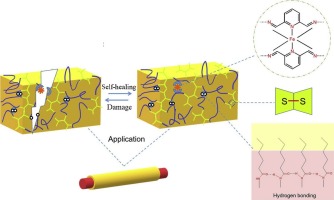当前位置:
X-MOL 学术
›
Prog. Org. Coat.
›
论文详情
Our official English website, www.x-mol.net, welcomes your
feedback! (Note: you will need to create a separate account there.)
A novel type of self-healing silicone elastomers with reversible cross-linked network based on the disulfide, hydrogen and metal-ligand bonds
Progress in Organic Coatings ( IF 6.5 ) Pub Date : 2020-07-01 , DOI: 10.1016/j.porgcoat.2020.105661 Yuetao Liu , Junguo Yuan , Kaiming Zhang , Keyu Guo , Lin Yuan , Yumin Wu , Chuanhui Gao
Progress in Organic Coatings ( IF 6.5 ) Pub Date : 2020-07-01 , DOI: 10.1016/j.porgcoat.2020.105661 Yuetao Liu , Junguo Yuan , Kaiming Zhang , Keyu Guo , Lin Yuan , Yumin Wu , Chuanhui Gao

|
Abstract Herein, we report an innovative cross-linked network of silicone elastomer with good stretchability, thermal stability and autonomous self-healing. This type of elastomers was easily prepared by aminopropyl terminated polydimethylsiloxane (A-PDMS), thioctic acid (TA) and 2,6-pyridine dialdehyde (Py). As we know, TA was firstly incorporated into the reversible network of silicones to supply the dynamic disulfide bonds and endow the self-healing properties. Py was also introduced into the network which acted as the metal-ligand binding sites. Consequently, silicone elastomers with three different types of chemical interactions including the disulfide bonds, hydrogen bonds and metal-ligand bonds were obtained. Especially, they possessed good anticorrosion and strong adhesion affinity. We expected this type of silicone elastomers could be applied into the soft robotics, wearable electronics and stretchable circuit constructed.
中文翻译:

基于二硫键、氢键和金属-配体键的具有可逆交联网络的新型自修复有机硅弹性体
摘要在此,我们报告了一种创新的有机硅弹性体交联网络,具有良好的拉伸性、热稳定性和自主自愈能力。这种类型的弹性体很容易通过氨基丙基封端的聚二甲基硅氧烷 (A-PDMS)、硫辛酸 (TA) 和 2,6-吡啶二醛 (Py) 制备。众所周知,TA首先被加入到有机硅的可逆网络中,以提供动态二硫键并赋予自修复性能。Py 也被引入作为金属配体结合位点的网络中。因此,获得了具有三种不同类型化学相互作用的有机硅弹性体,包括二硫键、氢键和金属-配体键。尤其是它们具有良好的防腐性和很强的附着力。
更新日期:2020-07-01
中文翻译:

基于二硫键、氢键和金属-配体键的具有可逆交联网络的新型自修复有机硅弹性体
摘要在此,我们报告了一种创新的有机硅弹性体交联网络,具有良好的拉伸性、热稳定性和自主自愈能力。这种类型的弹性体很容易通过氨基丙基封端的聚二甲基硅氧烷 (A-PDMS)、硫辛酸 (TA) 和 2,6-吡啶二醛 (Py) 制备。众所周知,TA首先被加入到有机硅的可逆网络中,以提供动态二硫键并赋予自修复性能。Py 也被引入作为金属配体结合位点的网络中。因此,获得了具有三种不同类型化学相互作用的有机硅弹性体,包括二硫键、氢键和金属-配体键。尤其是它们具有良好的防腐性和很强的附着力。











































 京公网安备 11010802027423号
京公网安备 11010802027423号